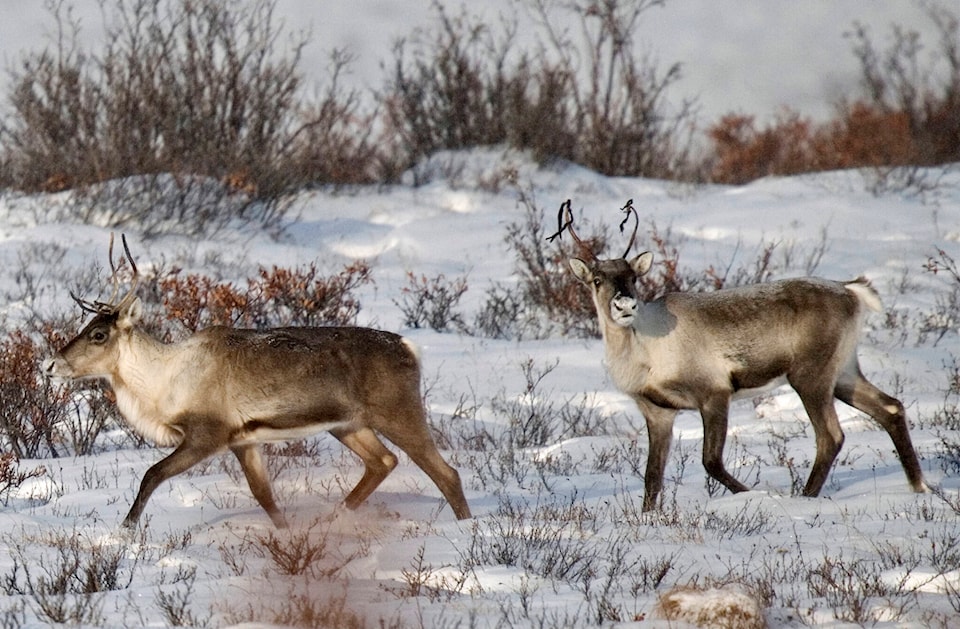The Yukon government has announced new or altered wildlife regulations affecting management and hunting opportunities for caribou, bison, wild sheep and grizzly bears. The new regulations all went into effect on April 1.
The regulation changes were all advanced by the Yukon Fish and Wildlife Management Board with the goal of supporting sustainable wildlife populations, ensuring responsible management and protecting critical habitats.
An adaptive management plan is now in place for the Hart River Caribou herd. Its range is located north of Dawson City.
According to the government announcement, the new management plan will not result in immediate changes to licensed hunting, and hunters who have a caribou seal will automatically receive a Wildlife Act permit to hunt the heard.
The Nelchina caribou herd that ranges out of Alaska will be open for licensed harvest on December 1 but the details of that hunting opportunity are still being finalized.
“Management of this herd will be decided with our partners and details about this new hunting opportunity will be announced later in the season. Hunters will be required to re-print their hunting licenses prior to the August 1 hunting season for updated conditions regarding the Nelchina caribou herd harvest opportunity,” the announcement reads.
Steven Hossack, a representative of the fish and wildlife management board, said the opening of a hunt on the Nelchina caribou is a response to encouraging signs about its population. The caribou are already being harvested on the Alaska side of the border. Hossack said the government, the fish and wildlife management board, the local renewable resources council and possibly groups on the Alaska side of the border will get a say in the development of the regulations for the hunt.
The rules around the roadside hunting of grizzly bears in the southern part of the territory are being tightened. Roadside hunting for bears will be prohibited south of Whitehorse within 100 metres on either side of the centreline of the Alaska highway between the M’Clintock River Bridge and Jakes Crossing.
The 100-metre buffer will also apply to the Tagish Road and the Atlin Road to the B.C. border. The Carcross/Tagish Renewable Resources Council and the Taku River Tlingit proposed the roadside buffer for grizzly hunting.
Also announced was a snowmobile closure for the Ddhaw Ghro Habitat Protection Area, a mountainous area located between the Pelly and Stewart Rivers.
As proposed by the Alsek Renewable Resources Council, bison hunters will now be able to recover harvested wolves and coyotes while bison hunting in game management zone 5, north of Kluane National Park. Hossack said this regulation change rectified a flaw in the rules that allowed the hunters to kill the wolves and coyotes but not to remove them from the area on their snowmobiles.
A regulation change will allow the minister of Environment to access money in a conservation fund that will provide funding opportunities for initiatives by organizations and individual Yukoners relating to the conservation, protection and management of wildlife and habitat.
Ahead of the 2022/23 season the way permit hunt authorizations for sheep are allocated is being changed. The public notice about the regulation change states that in game management zone 7 east the permit hunt authorizations will mostly be issued by game management subzone but the sheep management units will still be used to evaluate harvest sustainability. Hassock said this change is a response to concerns from hunters about congestion and pressure created in some areas when the hunts were being allocated by sheep management unit.
Hassock said the new or changed regulations that went into effect April 1 were all initially proposed in the spring of 2019. After regulations are proposed and reviewed by a committee from the management board and the Department of Environment there is a consultation process with First Nations and the public at large. Final recommendations from the board then have to be approved first by the minister of Environment and then cabinet before becoming official regulations.
Contact Jim Elliot at jim.elliot@yukon-news.com
